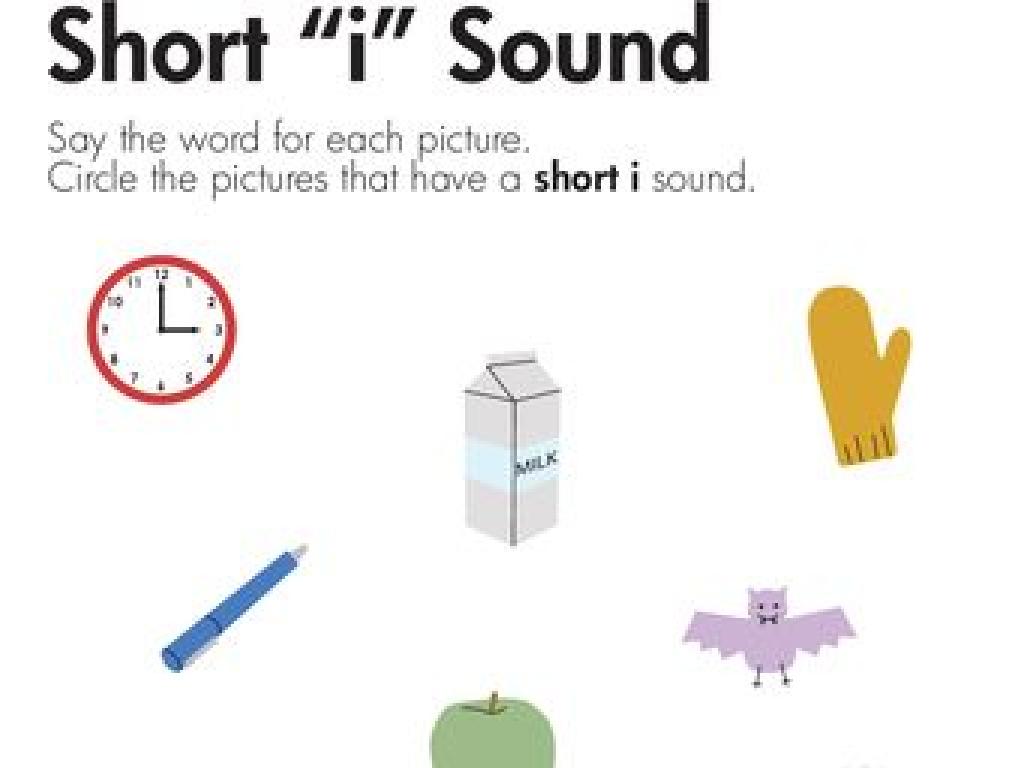Subject-Verb Agreement
Subject: Language arts
Grade: Third grade
Topic: Verb Types
Please LOG IN to download the presentation. Access is available to registered users only.
View More Content
Understanding Verb Types
– Welcome to Language Arts!
– Verbs & subjects work together
– Verbs tell us what the subject does
– Different types of verbs
– Action, linking, and helping verbs
– Why verb types matter
– Helps make our sentences clear
|
Today’s lesson introduces the concept of verbs and their agreement with subjects. Begin by welcoming students and explaining that verbs are action words that tell us what the subject of a sentence is doing. Discuss the different types of verbs: action verbs show what action is being performed, linking verbs connect the subject to more information, and helping verbs assist the main verb. Emphasize the importance of using the correct verb type to make sentences clear and understandable. Use examples to illustrate each type of verb and how they work in a sentence. Encourage students to think of verbs as the ‘heart’ of a sentence that keeps the ‘body’ of the sentence moving.
Understanding Verbs
– Verbs show action or state
– Like ‘run’ means to move fast on feet
– Examples: ‘run’, ‘jump’, ‘is’, ‘are’
– ‘Is’ and ‘are’ show what someone or something is like
– Verbs tell us subject’s action
– If a cat ‘jumps’, the cat is the subject doing the action
– Verbs are important in sentences
|
Begin by explaining that a verb is a fundamental part of a sentence that indicates what the subject is doing or its state of being. Use physical actions like ‘run’ and ‘jump’ to illustrate action verbs, which are easier for children to understand through activities like acting out the verbs. Then, explain ‘is’ and ‘are’ as state of being verbs, which describe a condition or existence. Emphasize the importance of verbs in sentences and how they relate to the subject. For example, ‘The dog runs’ tells us what the dog (the subject) is doing. Encourage students to think of verbs as the ‘doing’ words in a sentence.
Subject-Verb Agreement
– Subjects & verbs must match
– Singular subjects need singular verbs
– If ‘dog’ barks, we say ‘dog barks’ not ‘dog bark’
– Plural subjects need plural verbs
– For ‘dogs’ we say ‘dogs bark’ not ‘dogs barks’
– Practice makes perfect!
– Let’s try with some examples together in class!
|
This slide introduces the basic concept of subject-verb agreement to third graders. Emphasize the importance of matching the subject with the correct form of the verb depending on whether the subject is singular or plural. Use everyday examples that the students can relate to, such as animals they are familiar with or objects in the classroom. Encourage the students to practice by creating sentences as a class and correcting sentences that don’t follow the subject-verb agreement rule. Provide additional examples and exercises for them to work on, and consider incorporating a game or activity where they can correct sentences in a fun and interactive way.
Singular and Plural Subjects
– Singular subjects use singular verbs
– Example: ‘The dog runs fast.’
– Plural subjects use plural verbs
– Example: ‘The dogs run fast.’
– Verbs change with the subject number
– Practice makes perfect
– Let’s try with different subjects!
|
This slide introduces the concept of subject-verb agreement to third-grade students. Start by explaining that a singular subject (like one dog) uses a singular verb (runs), while a plural subject (like many dogs) uses a plural verb (run). Highlight how the verb form changes depending on whether the subject is singular or plural. Provide additional examples and encourage students to come up with their own sentences. Practice with the class by giving them various subjects and asking them to choose the correct verb form. This will help reinforce the concept through repetition and active participation.
Matching Subjects with Verbs
– Match the right verb to the subject
– Practice with ‘to be’ verbs
– ‘Is’ and ‘are’ show present state, ‘was’ and ‘were’ for past
– Singular and plural examples
– ‘I am’ is singular, ‘We are’ is plural
– ‘I am’, ‘You are’, ‘He/She/It is’
– Ensure ‘is’ matches singular subjects, ‘are’ with plural
|
This slide is aimed at helping third-grade students understand the concept of subject-verb agreement, particularly with the ‘to be’ verbs. Start by explaining that verbs must match the subject in number (singular or plural). Use ‘to be’ verbs as clear examples: ‘is’ and ‘are’ for the present tense, ‘was’ and ‘were’ for the past tense. Provide examples for each pronoun to illustrate the agreement: ‘I am’, ‘You are’, ‘He/She/It is’, ‘We are’, ‘They are’. Engage the class with practice sentences where they choose the correct verb form. Encourage students to explain why they chose ‘is’ or ‘are’ in each case to reinforce their understanding.
Let’s Practice Subject-Verb Agreement!
– I’ll show sentences with blanks
– You pick the right verb form
– Check if the subject is singular or plural
– Is it ‘dog barks’ or ‘dogs bark’?
– Let’s get the verbs right together!
|
This slide is for an interactive class activity focused on subject-verb agreement. Present sentences with missing verbs and have students fill in the blanks with the correct verb forms. Remind them to determine whether the subject is singular or plural as this will affect the verb form. For example, ‘The cat (run/runs) fast’ versus ‘The cats (run/runs) fast.’ Prepare a list of sentences with varying subjects and verbs for the students to practice with. Encourage them to explain why they chose the verb form they did to reinforce the concept. Have additional sentences ready for students who finish early or for those who may need extra practice.
Class Activity: Verb Hunt
– Read a story as a class
– Underline all the verbs
– Verbs are action words like ‘run’, ‘eat’, ‘jump’
– Check subject-verb agreement
– Singular subjects need singular verbs; plurals need plural verbs
– Discuss our findings
|
This interactive activity is designed to help students identify verbs within the context of a story and understand the concept of subject-verb agreement. As the teacher, you will guide the class through a short story, encouraging them to find and underline all the verbs. Emphasize the importance of matching the verb to the subject in number (singular or plural). After the activity, facilitate a discussion where students share the verbs they found and explain why they agree with their subjects. Possible variations of the activity could include working in pairs, creating a competition, or having students write their own sentences that demonstrate subject-verb agreement.
Wrapping Up: Subject-Verb Agreement
– Congratulations on learning subject-verb agreement!
– Subjects and verbs must match in number
– If the subject is singular, the verb must be singular too
– Keep practicing by reading more
– Reading helps you see more examples of how verbs match with subjects
– Identify verbs in sentences as you read
– Spot verbs and check if they agree with the subjects
|
Great work, students! You’ve learned an important part of grammar: making sure subjects and verbs agree. Remember, if a subject is singular, use a singular verb; if it’s plural, use a plural verb. Encourage students to continue practicing by reading books and identifying the verbs in sentences. This will help them internalize the rules and recognize patterns in subject-verb agreement. In the next class, we can have a quick review and perhaps a fun activity to reinforce today’s lesson.





